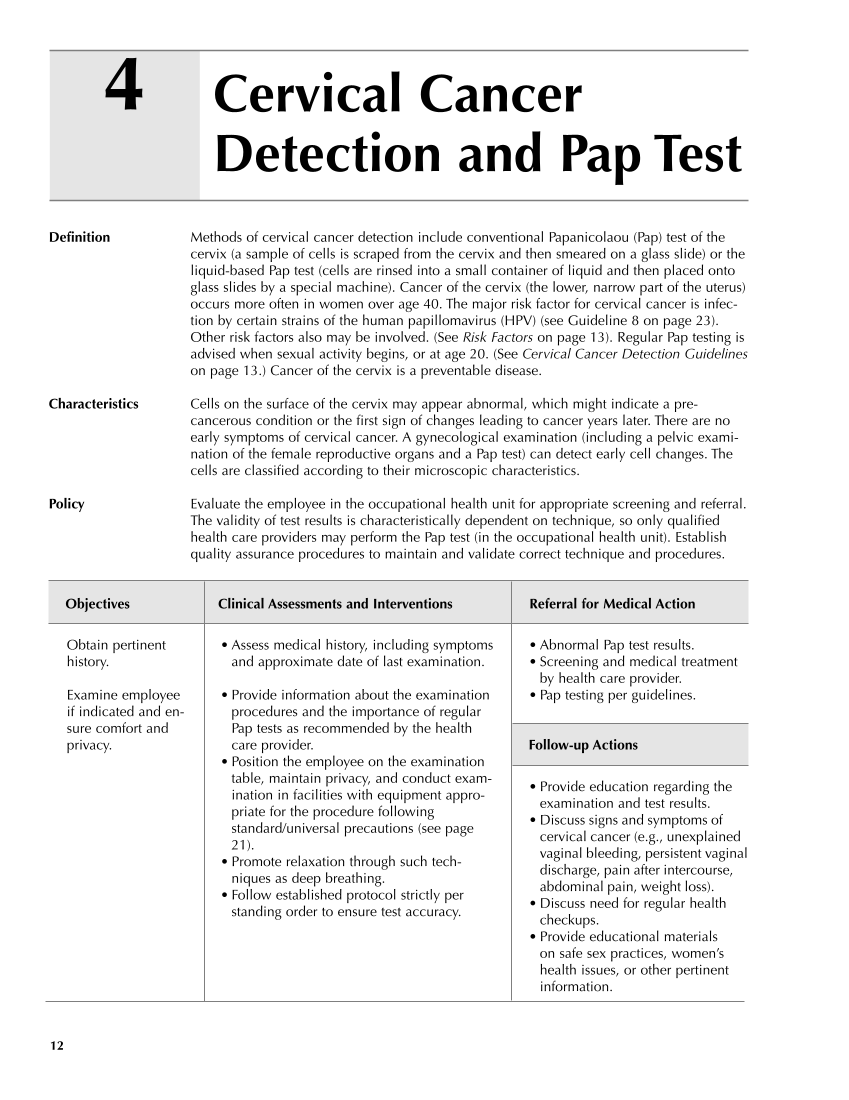12 Cervical Cancer Detection and Pap Test 4 Definition Methods of cervical cancer detection include conventional Papanicolaou (Pap) test of the cervix (a sample of cells is scraped from the cervix and then smeared on a glass slide) or the liquid-based Pap test (cells are rinsed into a small container of liquid and then placed onto glass slides by a special machine). Cancer of the cervix (the lower, narrow part of the uterus) occurs more often in women over age 40. The major risk factor for cervical cancer is infec- tion by certain strains of the human papillomavirus (HPV) (see Guideline 8 on page 23). Other risk factors also may be involved. (See Risk Factors on page 13). Regular Pap testing is advised when sexual activity begins, or at age 20. (See Cervical Cancer Detection Guidelines on page 13.) Cancer of the cervix is a preventable disease. Characteristics Cells on the surface of the cervix may appear abnormal, which might indicate a pre- cancerous condition or the first sign of changes leading to cancer years later. There are no early symptoms of cervical cancer. A gynecological examination (including a pelvic exami- nation of the female reproductive organs and a Pap test) can detect early cell changes. The cells are classified according to their microscopic characteristics. Policy Evaluate the employee in the occupational health unit for appropriate screening and referral. The validity of test results is characteristically dependent on technique, so only qualified health care providers may perform the Pap test (in the occupational health unit). Establish quality assurance procedures to maintain and validate correct technique and procedures. Objectives Clinical Assessments and Interventions Referral for Medical Action • Abnormal Pap test results. • Screening and medical treatment by health care provider. • Pap testing per guidelines. Follow-up Actions • Provide education regarding the examination and test results. • Discuss signs and symptoms of cervical cancer (e.g., unexplained vaginal bleeding, persistent vaginal discharge, pain after intercourse, abdominal pain, weight loss). • Discuss need for regular health checkups. • Provide educational materials on safe sex practices, women’s health issues, or other pertinent information. Obtain pertinent history. Examine employee if indicated and en- sure comfort and privacy. • Assess medical history, including symptoms and approximate date of last examination. • Provide information about the examination procedures and the importance of regular Pap tests as recommended by the health care provider. • Position the employee on the examination table, maintain privacy, and conduct exam- ination in facilities with equipment appro- priate for the procedure following standard/universal precautions (see page 21). • Promote relaxation through such tech- niques as deep breathing. • Follow established protocol strictly per standing order to ensure test accuracy. Guideline continues on next page
Purchased from OEM Press by (ge corporate access). (C) 2013 OEM Health Information, Inc. All rights reserved.












































































































































































































































































































































































































































